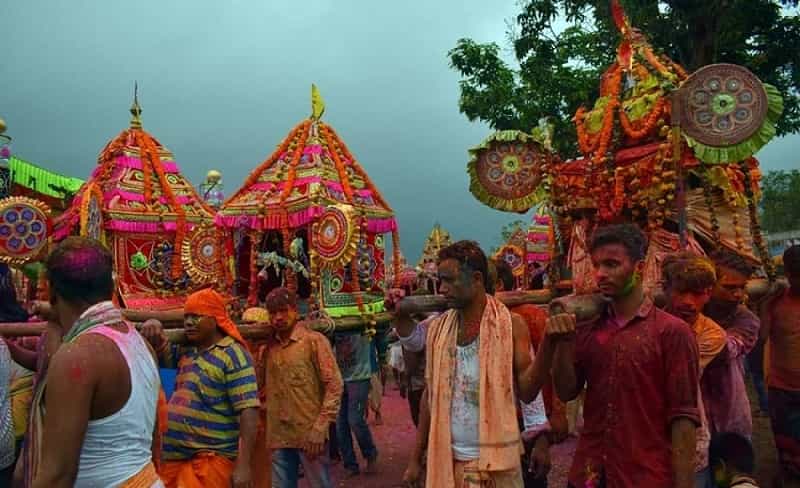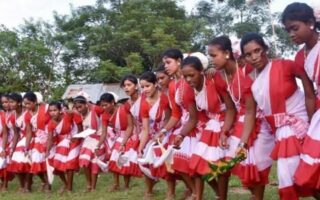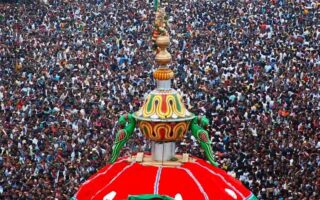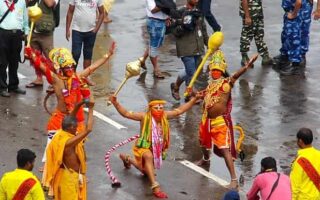- Area: All over the state of Odisha
- Falls In the month of: (Phalguna or Falguna Purnima (March)
- Other Name: Spring Festival, Vasantotsav
- Duration: 5days
- A colorful fiesta: The fiesta of colors
- Dates for 2024: Mon, Mar 25
Holi (Fiesta of Colors) or Dola Purnima is a famous festival celebrated in the inshore Districts of (Orissa). This festival is celebrated on the Purnima, in the holy month of (Falguna). This festival is during the spring season and it is enjoyed and welcomed, with amusement and cheerfulness. Holi is cited in the ancient texts as spring festival or ” Vasantotsav”.

A number of sacred scriptures gives evidence that (“Madanotsava”), the fiesta held in admiration of (‘Madana’) also called as the angel was afterward changed as the swing festival or “Dolatsaba” of Krishna. As a result, Lord Krishna is appeased on this juncture as (“Madana Mohana”). The Portrayal of the fiesta as (Dolatsaba) is mentioned in many (‘Puranas’) and additional Sanskrit texts. ‘Padma Purana’ articulates that whosoever gets a glimpse of Lord Krishna swinging in the dangle is atoned of each and every sin.
- Also Read: Popular Fair and Festivals of Odisha
Celebration of Holi in the state of Orissa
Although the fiesta of Holi is celebrated only for one day, it is feted with great amusement and cheerfulness all across the country, the fiesta is fêted for a period of five days in this state. It commences from the 10th day of the dazzling fortnight, in the calendar month of (Falguna) also called as (“Fagu Dasami”). Aspersing the face with colored powder known as ‘Abira’ all the people carry out rounds of the deity of Madanamohana) in luxuriantly bedecked palanquins called as ” vimana”.
The Parade
The parade is headed by the pipers, Sankirtan Mandalis and drummers of the village. The parade stops in the presence of each and every menage and the idol is presented ‘Bhog’. The everyday circles of the idol for 4 days are known as (“Chachery”). The final day commences the fiesta of swing for all the deities. The deities held in (Veemanas) from many villages accumulates in a significant position where dangles are present on a podium. Swinging actions take place for each idols and devotional music is also sung.
In ancient days, the commencement of (New Year) was considered from the season of spring. Subsequent to the swing fiesta of the idols, the Jyotisha or ‘Ganaka’ or (uranologist-cum-future teller) interprets the new-fangled Oriya calendar and describes the significant events which will take place annually. Because of this reason, some believe that this fiesta is feted for New Year.
The Fable of This Festival
On the 14th day of the fortnight, an affair in that a (straw-hut) is put to fire amongst much pleasure and thrill. This is called as blazing of Holi or “Holipoda”. The fable traces that, ‘Holika’ was a good-looking sister of (‘Hiranyakashipu’), the king of the demons. As a passionate worshipper of Shiva, Holika got the advantage that she would be saved from burning and drowning.
Apart from all his atrocious efforts, Hiranyakashyapu could not slay Prahlada, his son, the worshipper of Vishnu. Demon Hiranyakashyapu had decided to burn his son in to ashes. Holika was asked to conclude this task, as she would not be burnt. Therefore, she sat with Prahlad on the blazing Fire but surprisingly Prahlad was not burnt and instead of him, Holika was dead with burn marks all around her body. Infuriated by this act, Demon king, Hiranya questioned Lord Shiva regarding the inefficaciousness of His advantage, to this Lord Shiva answered, “I approved her the advantage to guard herself and not to slay anyone.”
As an evocation to this, Holipoda is fêted and the subsequent day is celebrated as the fiesta of colors (‘Holi’), in which all the People smudge colors on every one and also spurts colored waters. The amount of merriment and fun is at its highest level.
Mendhapodi
The ritual of ablazing straw shelter is called as “Mendhapodi”. A myth emotionally involved to it reads out that, a devil called as (‘Mesha’) was inducing fright in the paradise and Earth, every body including Gods and human beings pleaded Lord Krishna to save them from his carnages. Lord Krishna slayed and blistered him to vestiges. Therefore, to evocate this occasion a small hut is blistered that symbolizes the house of the deadly demon.
Fairs of Holi
Huge and colorful fairs are organized in many numerous places of Orissa. In these fairs, deities of Gods are brought together. These fiestas are known as “Melana”. The Veemanas or the palanquins of the nearby villages are set in a line for free view. Competitions are also kept for the best decorations of the Veermanas. At the end of these fairs, fire work takes place in the front of all the Veermanas. These fireworks are very interesting and many tourist visits these fairs to get the ethnic flavor of Orissa.
These fairs also sell furnitures agricultural implements, household articles and commodities .Such fairs or Melanas carries on till Chaitra Month. You can explore these exotic melas in places such as Puri, Ganjam and Cuttack.
- Must Read: Top 10 Best Things To Do In Odisha


